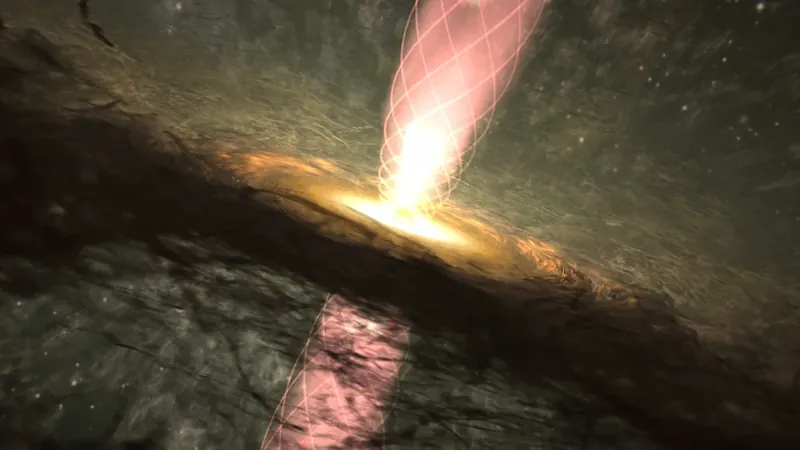
Groundbreaking Discovery: Helical Magnetic Field Detected in Protostellar Jets!
2025-01-12
Author: Siti
Groundbreaking Discovery: Helical Magnetic Field Detected in Protostellar Jets!
In a revolutionary finding, a team of astronomers led by Adriana Rodríguez-Kamenetzky and Alice Pasetto has unveiled the first 3D visualization of a helical magnetic field within the protostellar jets of HH 80-81. This significant research was carried out at the Institute of Theoretical and Experimental Astronomy (IATE) in Argentina, under the auspices of the National Scientific and Technical Research Council and the National University of Cordoba (CONICET-UNC).
Understanding Protostellar Jets
Protostellar jets are powerful streams composed of matter and energy often found in systems with young stars and supermassive black holes. Despite their prevalence across the universe, the mechanisms behind their collimation have remained shrouded in mystery—until now.
The Significance of the HH 80-81 Jet
The HH 80-81 jet, powered by a massive protostar, provides compelling evidence of a helical magnetic field, a phenomenon previously documented in jets emanating from active galactic nuclei. The lead investigator, Adriana Rodríguez-Kamenetzky, emphasized the significance: “This is the first solid evidence that helical magnetic fields can explain astrophysical jets at different scales, thus supporting the universality of the collimation mechanism.”
Research Methods and Data Collection
This research utilized the advanced capabilities of the National Science Foundation's Very Large Array (VLA), which was upgraded recently. Observations extended over four sessions in late 2018 and were conducted at centimeter wavelengths (4 to 8 GHz), accumulating a remarkable 20 hours of data. Located about 1,200 to 1,400 parsecs (nearly 4,000 to 4,600 light years) away, HH 80-81 features a highly collimated outflow powered by its massive young star.
Analyzing the Magnetic Architecture
To unravel the complex magnetic architecture within the jet, researchers applied sophisticated Rotation Measure (RM) analysis, correcting for Faraday rotation effects, which enabled them to map the true magnetic field structure accurately.
A Detailed Look at the Research Techniques
The team meticulously calibrated their data using the Common Astronomy Software Applications (CASA) package, which facilitated polarization calibration. By capturing the jet’s polarized emissions and deriving Stokes parameters (I, Q, and U) for each spectral window, they were able to conduct a profound rotation measure analysis. This process revealed intrinsic polarization vectors and the magnetic field orientation by examining variations in polarization angle and intensity that depend on wavelength.
Unveiling the Helical Magnetic Structure
The findings disclosed a helical magnetic field structure within the HH 80-81 jet. These helical fields result from the intricate interplay between poloidal and toroidal magnetic components, both generated by the rotation of the protostar's accretion disk. Remarkably, the study identified transverse RM gradients across both the jet and its counterjet, affirming the existence of a toroidal magnetic field that corroborates theoretical models explaining how jets are guided and focused.
Implications for Astrophysics
Alice Pasetto, a renowned astrophysicist involved in the research, remarked, “For the first time, we were able to study the 3D configuration of the magnetic field in a protostellar jet.” This pivotal work allows scientists to draw comparisons with jets from active galactic nuclei, which often exhibit faint counterjets due to Doppler boosting. The HH 80-81 jet's unique structure facilitates simultaneous observation of both the jet and its counterjet, enabling researchers to conclude that the helical magnetic field originates from within the jet-disk system rather than external influences.
Looking Back at Previous Studies
“The intent behind our earlier 2010 study using the VLA was to detect non-thermal emissions and the magnetic field presence, but we couldn’t probe into its 3D structure then,” noted Carlos Carrasco-González, a co-author of the study, reflecting on the developments achieved since.
The Future of Jet Research
The findings strongly indicate that helical magnetic fields play an essential, universal role in the collimation of astrophysical jets across various scales. This notion is reinforced by the similar jet structures found in supermassive black holes, suggesting a common underlying mechanism.
With advancements in next-generation instruments like the Square Kilometre Array (SKA) and the Next Generation Very Large Array (ngVLA), researchers are poised to delve deeper into magnetic fields associated with jets. These developments promise higher-resolution studies of magnetic fields near protostars and other sources of jet phenomena.
Conclusion
The identification of a helical magnetic field in HH 80-81 not only alters our understanding of protostellar jets but also ignites a new path for investigating cosmic phenomena, merging two significant areas of astrophysics into one compelling narrative of discovery. Get ready for more exciting revelations from the universe!
 Brasil (PT)
Brasil (PT)
 Canada (EN)
Canada (EN)
 Chile (ES)
Chile (ES)
 Česko (CS)
Česko (CS)
 대한민국 (KO)
대한민국 (KO)
 España (ES)
España (ES)
 France (FR)
France (FR)
 Hong Kong (EN)
Hong Kong (EN)
 Italia (IT)
Italia (IT)
 日本 (JA)
日本 (JA)
 Magyarország (HU)
Magyarország (HU)
 Norge (NO)
Norge (NO)
 Polska (PL)
Polska (PL)
 Schweiz (DE)
Schweiz (DE)
 Singapore (EN)
Singapore (EN)
 Sverige (SV)
Sverige (SV)
 Suomi (FI)
Suomi (FI)
 Türkiye (TR)
Türkiye (TR)
 الإمارات العربية المتحدة (AR)
الإمارات العربية المتحدة (AR)